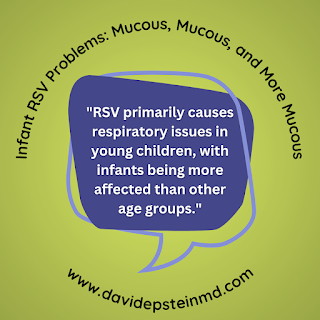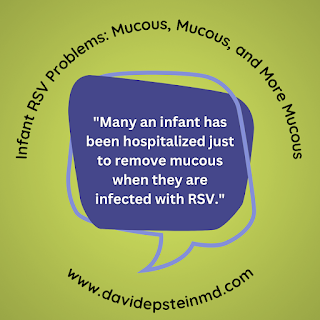Infants and Respiratory Syncytial Virus (RSV) don’t mix well. As we’ve begun to see at this time, creeping toward winter, RSV has been more widespread than it has been over the last few years. But, RSV has always been around. We’ve seen it before. It may just be that the numbers are a bit higher at the moment. Nevertheless, if RSV could have its own quote this season, it would likely be from the lyrics of an LL Cool J song, “Don’t call it a comeback, I been here for years…”
RSV primarily causes respiratory issues in young children, with infants being more affected than other age groups. Not only does the virus affect the lung tissue to cause breathing problems, but it also causes a significant amount of upper airway mucous production which, in turn, causes significant breathing difficulties in young infants. Young infants are obligate nose breathers which means that they tend to primarily breathe through their noses. RSV causes a significant amount of mucous production in the nasopharynx to cause the nose to become completely blocked in many cases. Additionally, mucous drips down the back of the throat as well. Parents are shocked at the amount of mucous produced when infants become infected with RSV.
It is this nasal blockage with mucous that can send an infant to the hospital. They have trouble breathing because of the congestion and can’t feed well because they can’t breathe and feed at the same time. So, they can develop respiratory distress and dehydration just by the sheer fact that the upper airway mucous is obstructing the passage of air from the nose/mouth area into the lungs. So, what is one to do?
Well, it is important to get ahead of the game with nasal (and oral) suctioning. Removing the mucous is the key for many infants and it can keep them out of the hospital. Using a regular bulb suction or a commercial device to remove the mucous is so important. Also, placing a drop or two of regular saline in the nose (on each side) before suctioning the mucous can facilitate mucous removal. The saline drops help thin the mucous a bit, so the mucous can be evacuated easier. While there may be adjunctive medications or treatments that can be used to support the respiratory status of infants with RSV, the most important therapy is removing the nasal mucous regularly.
Many an infant has been hospitalized just to remove mucous when they are infected with RSV. I have seen infants solely require frequent nasal (and oral) suctioning at an interval that would be too frequent for parents to do at home. Suctioning every hour, or more frequently, is not uncommon for infants admitted to the hospital with RSV. In fact, the only management plan may be to just remove the mucous from the upper airways. It seems like such a low-tech, basic, and easy thing to do, but suctioning mucous from an infant’s nose and mouth can be the difference between a good and bad outcome with RSV.
As a parent, what scares you the most about RSV?
Get free and instant access to the most current Epstein’s Pearls articles! Get it now!



Comments
Post a Comment